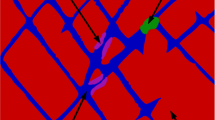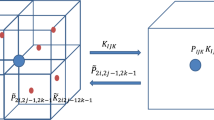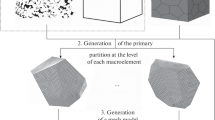Abstract
An image-based effective medium approximation (EMA) is developed so as to permit very fast transport properties evaluations of 3D porous media. From an image-based porous network (IBPN) built upon digital image processing of 3D binary images, we focus on throat’s local geometrical properties at the pore scale, for being the most sensible structural units which build up the local pressure. This approach is a 3D image–based extension of the critical point approach proposed in 2D fractures. We show, from analyzing various core rock samples available in the literature, that the asymptotic assumptions associated with the preeminence of critical points in throats are indeed geometrically relevant. We then describe how the image-based EMA evaluated from the conductances computed from the discrete IBPN can be reliably evaluated. The proposed method is evaluated upon the estimation of core sample permeability from binarized image obtained using X-ray tomography. Since it combines digital image treatments with statistical data post-processing without the need of computational fluid dynamics (CFD) computation, it is extremely cost efficient. The results are compared with a micro-scale Stokes flow computation in various rock samples. The sensitivity to the pore discretization also is discussed and illustrated.
Similar content being viewed by others
References
Alhashmi, Z., Blunt, M., Bijeljic, B.: The impact of pore structure heterogeneity, transport, and reaction conditions on fluid–fluid reaction rate studied on images of pore space. Transp. Porous Media 115(2), 215–237 (2016)
Amyot, O., Plouraboué, F.: Capillary pinching in a pinched microchannel. Phys. Fluids 19 (3), 033101 (2007)
Andrae, H., Combaret, N., Dvorkin, J., Glatt, E., Han, J., Kabel, M., Keehm, Y., Krzikalla, F., Lee, M., Madonna, C., Marsh, M., Mukerji, T., Saenger, E. H., Sain, R., Saxena, N., Ricker, S., Wiegmann, A., Zhan, X.: Digital rock physics benchmarks-part I: imaging and segmentation. Comput. Geosci. 50, 25–32 (2013)
Andrae, H., Combaret, N., Dvorkin, J., Glatt, E., Han, J., Kabel, M., Keehm, Y., Krzikalla, F., Lee, M., Madonna, C., Marsh, M., Mukerji, T., Saenger, E. H., Sain, R., Saxena, N., Ricker, S., Wiegmann, A., Zhan, X.: Digital rock physics benchmarks-part II: computing effective properties. Comput. Geosc. 50, 33–43 (2013)
Araya-Polo, M., Alpak, F.O., Hunter, S., Hofmann, R., Saxena, N.: Deep learning–driven permeability estimation from 2D images. Comput. Geosci. 1–10 (2019)
Auradou, H.: Influence of wall roughness on the geometrical, mechanical and transport properties of single fractures. J. Phys. D: Appl. Phys. 42(21), 214015 (2009)
Bakke, S.: ØRen, P.E., others: 3-D pore-scale modelling of sandstones and flow simulations in the pore networks. SPE J. 2(02), 136–149 (1997)
Baldwin, C.A., Sederman, A.J., Mantle, M.D., Alexander, P., Gladden, L.F.: Determination and characterization of the structure of a pore space from 3D volume images. J. Colloid Interface Sci. 181 (1), 79–92 (1996)
Bernabé, Y., Olson, J.F.: The hydraulic conductance of a capillary with a sinusoidally varying cross-section. Geophys. Res. Lett. 27(2), 245–248 (2000)
Bertrand, G.: On p-simple points. Comptes Rendus de l’académie des Sciences. Série Math. 1(321), 1077–1084 (1995)
Bijeljic, B., Mostaghimi, P., Blunt, M.J.: Insights into non-fickian solute transport in carbonates. Water Resour. Res. 49(5), 2714–2728 (2013)
Bijeljic, B., Raeini, A., Mostaghimi, P., Blunt, M.J.: Predictions of non-Fickian solute transport in different classes of porous media using direct simulation on pore-scale images. Phys. Rev. E 87(1), 013011 (2013)
Blum, H.: Biological shape and visual science (part I). J. Theor. Biol. 38(2), 205–287 (1973)
Blunt, M.J., Bijeljic, B., Dong, H., Gharbi, O., Iglauer, S., Mostaghimi, P., Paluszny, A., Pentland, C.: Pore-scale imaging and modelling. Adv. Water Resour. 51, 197–216 (2013)
Botev, Z.I., Grotowski, J.F., Kroese, D.P., et al.: Kernel density estimation via diffusion. Ann. Stat. 38(5), 2916–2957 (2010)
Bouix, S., Siddiqi, K., Tannenbaum, A.: Flux driven automatic centerline extraction. Med. Image Anal. 9(3), 209–221 (2005)
Bruggeman, V.D.: Berechnung verschiedener physikalischer konstanten von heterogenen substanzen. i. dielektrizitätskonstanten und leitfähigkeiten der mischkörper aus isotropen substanzen. Ann. Phys. 416(7), 636–664 (1935)
Bultreys, T., De Boever, W., Cnudde, V.: Imaging and image-based fluid transport modeling at the pore scale in geological materials: a practical introduction to the current state-of-the-art. Earth-Sci. Rev. 155, 93–128 (2016)
Cao, T.T., Tang, K., Mohamed, A., Tan, T.S.: Parallel banding algorithm to compute exact distance transform with the GPU. In: Proceedings of the 2010 ACM SIGGRAPH symposium on Interactive 3D Graphics and Games, pp. 83–90 (2010)
Deng, W., Iyengar, S.S., Brener, N.E.: A fast parallel thinning algorithm for the binary image skeletonization. Int. J. High Perform. Comput. Appl. 14(1), 65–81 (2000)
Guan, K.M., Nazarova, M., Guo, B., Tchelepi, H., Kovscek, A.R., Creux, P.: Effects of image resolution on sandstone porosity and permeability as obtained from x-ray microscopy. Transp. Porous Media. 1–13 (2018)
Guibert, R., Horgue, P., Debenest, G., Quintard, M.: A comparison of various methods for the numerical evaluation of porous media permeability tensors from pore-scale geometry. Math. Geosci. 48 (3), 329–347 (2016)
Guibert, R., Nazarova, M., Horgue, P., Hamon, G., Creux, P., Debenest, G.: Computational permeability determination from pore-scale imaging: sample size, mesh and method sensitivities. Transp. Porous Media 107(3), 641–656 (2015)
Guo, B., Ma, L., Tchelepi, H.A.: Image-based micro-continuum model for gas flow in organic-rich shale rock. Adv. Water Resour. 122, 70–84 (2018)
Horgue, P., Guibert, R., Gross, H., Creux, P., Debenest, G.: Efficiency of a two-step upscaling method for permeability evaluation at Darcy and pore scales. Comput. Geosci. 19(6), 1159–1169 (2015)
Janert, P.: Data analysis with open source tools: a hands-on guide for programmers and data scientists. “O’Reilly Media Inc” (2010)
Jiang, Z., Wu, K., Couples, G., van Dijke, M., Sorbie, K., Ma, J.: Efficient extraction of networks from three-dimensional porous media. Water Resour. Res. 43(12) (2007)
Landauer, R.: The electrical resistance of binary metallic mixtures. J. Appl. Phys. 23(7), 779–784 (1952)
Liang, Z., Ioannidis, M., Chatzis, I.: Geometric and topological analysis of three-dimensional porous media: pore space partitioning based on morphological skeletonization. J. Colloid Interface Sci. 221(1), 13–24 (2000)
Lindquist, W., Venkatarangan, A.: Investigating 3D geometry of porous media from high resolution images. Phys. Chem. Earth Part A: Solid Earth Geodesy 24(7), 593–599 (1999)
Lindquist, W.B., Lee, S.M., Coker, D.A., Jones, K.W., Spanne, P.: Medial axis analysis of void structure in three-dimensional tomographic images of porous media. Journal of Geophysical Research: Solid Earth 101(B4), 8297–8310 (1996)
Lotufo, R.A., Zampirolli, F.A.: Fast multidimensional parallel euclidean distance transform based on mathematical morphology. In: Proceedings XIV Brazilian Symposium on Computer Graphics and Image Processing, pp. 100–105. IEEE (2001)
Martin, H.: Lubrication of gear teeth. Engineering 102, 119 (1916)
Meijster, A., Roerdink, J.B., Hesselink, W.H.: A General Algorithm for Computing Distance Transforms in Linear Time. In: Mathematical Morphology and Its Applications to Image and Signal Processing, pp. 331–340. Springer (2002)
Mourzenko, V., Thovert, J.F., Adler, P.: Conductivity and transmissivity of a single fracture. Transp. Porous Media 123(2), 235–256 (2018)
Muljadi, B.P., Blunt, M.J., Raeini, A.Q., Bijeljic, B.: The impact of porous media heterogeneity on non-Darcy flow behaviour from pore-scale simulation. Adv. Water Resour. 95, 329–340 (2016)
Palágyi, K., Balogh, E., Kuba, A., Halmai, C., Erdȯhelyi, B., Sorantin, E., Hausegger, K.: A Sequential 3D Thinning Algorithm and Its Medical Applications. In: Biennial International Conference on Information Processing in Medical Imaging, pp. 409–415. Springer (2001)
Plouraboué, F., Flukiger, F., Prat, M., Crispel, P.: Geodesic network method for flows between two rough surfaces in contact. Phys. Rev. E 73(3), 036305 (2006)
Plouraboué, F., Geoffroy, S., Prat, M.: Conductances between confined rough walls. Phys. Fluids 16(3), 615–624 (2004)
Pudney, C.: Distance-ordered homotopic thinning: a skeletonization algorithm for 3D digital images. Comput. Vis. Image Understand. 72, 404–413 (1998)
Raeini, A.Q., Bijeljic, B., Blunt, M.J.: Generalized network modeling: network extraction as a coarse-scale discretization of the void space of porous media. Phys. Rev. E 96(1), 013312 (2017)
Raeini, A.Q., Blunt, M.J., Bijeljic, B.: Modelling two-phase flow in porous media at the pore scale using the volume-of-fluid method. J. Comput. Phys. 231(17), 5653–5668 (2012)
Saha, P.K., Borgefors, G., di Baja, G.S.: A survey on skeletonization algorithms and their applications. Pattern Recogn. Lett. 76, 3–12 (2016)
Saxena, N., Hofmann, R., Alpak, F.O., Berg, S., Dietderich, J., Agarwal, U., Tandon, K., Hunter, S., Freeman, J., Wilson, O.B.: References and benchmarks for pore-scale flow simulated using micro-CT images of porous media and digital rocks. Adv. Water Resour. 109, 211–235 (2017)
Saxena, N., Hows, A., Hofmann, R., Alpak, F.O., Freeman, J., Hunter, S., Appel, M.: Imaging and computational considerations for image computed permeability: operating envelope of digital rock physics. Adv. Water Resour. 116, 127–144 (2018)
Sheppard, A., Sok, R., Averdunk, H., Robins, V., Ghous, A.: Analysis of rock microstructure using high-resolution x-ray tomography. In: Proceedings of the International Symposium of the Society of Core Analysts, pp. 1–12 (2006)
Sherbrooke, E.C., Patrikalakis, N.M., Brisson, E.: An algorithm for the medial axis transform of 3D polyhedral solids. IEEE Trans. Vis. Comput. Graph. 2(1), 44–61 (1996)
Siddiqi, K., Bouix, S., Tannenbaum, A., Zucker, S.W.: Hamilton-Jacobi skeletons. Int. J. Comput. Vis. 48(3), 215–231 (2002)
Silverstein, C.: Google performance tools (2011)
Spanne, P., Thovert, J., Jacquin, C., Lindquist, W., Jones, K., Adler, P.: Synchrotron computed microtomography of porous media: topology and transports. Phys. Rev. Lett. 73(14), 2001 (1994)
Stroud, D.: Generalized effective-medium approach to the conductivity of an inhomogeneous material. Phys. Rev. B 12(8), 3368 (1975)
Stroud, D.: The effective medium approximations: some recent developments. Superlattices Microstruct. 23(3-4), 567–573 (1998)
Sudakov, O., Burnaev, E., Koroteev, D.: Driving digital rock towards machine learning: predicting permeability with gradient boosting and deep neural networks. Comput. Geosci. 127, 91–98 (2019)
Torquato, S.: Random heterogeneous materials: microstructure and macroscopic properties, vol. 16. Springer Science & Business Media (2013)
Torsello, A., Hancock, E.R.: Correcting curvature-density effects in the Hamilton–Jacobi skeleton. IEEE Trans. Image Process. 15(4), 877–891 (2006)
Tschumperlé, D.: The CImg Library. In: IPOL 2012 Meeting on Image Processing Libraries, pp. 4–Pp (2012)
Weller, H.G., Tabor, G., Jasak, H., Fureby, C.: A tensorial approach to computational continuum mechanics using object-oriented techniques. Comput. Phys. 12(6), 620–631 (1998)
Wildenschild, D., Sheppard, A.P.: X-ray imaging and analysis techniques for quantifying pore-scale structure and processes in subsurface porous medium systems. Adv. Water Resour. 51, 217–246 (2013)
Zhao, H.Q., Macdonald, I.F., Kwiecien, M.J.: Multi-orientation scanning: a necessity in the identification of pore necks in porous media by 3-D computer reconstruction from serial section data. J. Colloid Interface Sci. 162(2), 390–401 (1994)
Acknowledgments
We acknowledge PERM Group at Imperial College London to publicly share their binarized image sets.
Funding
This study was financially supported by Carnot Institute ISIfoR with ESTIME project. This work was performed using HPC resources from CALMIP (Grant P13147).
Author information
Authors and Affiliations
Corresponding author
Ethics declarations
Conflict of interest
The authors declare that they have no conflict of interest.
Additional information
Publisher’s note
Springer Nature remains neutral with regard to jurisdictional claims in published maps and institutional affiliations.
Appendices
Appendix
A conductance of an axisymmetrical tubular throat
In this section, we show how the leading order approximation for the conductance inside a tubular throat is given by Eq. (6). We consider Stokes equation associated with the velocity field u, the pressure p, and the dynamic viscosity μ
inside an axisymmetrical tubular throat having a variable radius R(z) along the longitudinal direction z, considering cylindrical coordinates (r, θ, z) (as the one represented in Fig. 2a). We chose the origin of the coordinate system at the throat minimum radius r0, so that R(z = 0) = r0. We consider a finite length throat where a fixed pressure drop is applied at edges z = ±L/2. Using the usual lubrication non-dimensionalization u = U(𝜖ur, 𝜖uθ, uz), where U is the main longitudinal velocity along the z direction. From axisymmetry uθ = 0. In the vicinity of the constriction, the following Taylor expansion of the local radius is
Considering tilde dimensionless variables, \(r=\tilde r r_{0}\), \(R=\tilde R r_{0}\) and \(z=\tilde z \frac {r_{0}}{\sqrt {r_{0}R_{zz}}}\), one finds
Using \(\epsilon =\sqrt {r_{0}R_{zz}} \ll 1\) as a small parameter, one can seek for an asymptotic expansion the velocity and pressure
when inserted into the expansion in power of 𝜖 of the operators of the Stokes problem (9) leads to the following leading order problem
The solution of this problem can be found easily
Computing the resulting leading order flux \(\tilde q^{0}\) from integrating the velocity in cylindrical coordinates between 0 and \(\tilde R(\tilde z)\) leads to
Looking for the head pressure loss gradient \(\partial _{\tilde {z}}\tilde {p}^{0}\),
integrating between 0 and \(\tilde {z}\), considering \(\tilde {p}(0)=0\) as pressure reference,
and considering limits for an infinitely long throat,
finally provides the following conductance for the whole throat:
Rights and permissions
About this article
Cite this article
Franc, J., Guibert, R., Horgue, P. et al. Image-based effective medium approximation for fast permeability evaluation of porous media core samples. Comput Geosci 25, 105–117 (2021). https://doi.org/10.1007/s10596-020-09991-0
Received:
Accepted:
Published:
Issue Date:
DOI: https://doi.org/10.1007/s10596-020-09991-0




